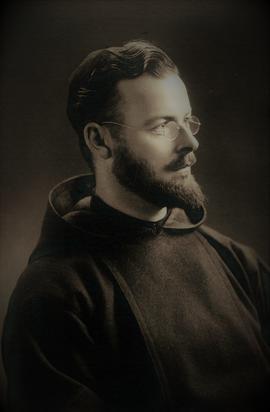O’Mahony, James, 1897-1962, Capuchin priest
- IE CA DB/86
- Persoon
- 6 April 1897-31 July 1962
Edward O’Mahony was born in Mitchelstown in County Cork on 4 April 1897. He attended the Seraphic College in Rochestown in County Cork and joined the Capuchin Order in October 1913 taking James as his religious name. He graduated with a first-class honours BA from University College Cork and was awarded the Pierce Malone scholarship in 1918. He later obtained an MA and was awarded a travelling scholarship in 1920. He attended the Catholic University of Louvain (Leuven) in Belgium and was awarded a highly acclaimed Licentiate in Philosophy in 1925 and a Doctorate in the following year. In 1928 he was awarded the title of Professor Agrégé from Louvain, the first Irishman to achieve such a distinction. On his return to Ireland, he was appointed superior of St. Bonaventure’s Hostel in Cork and was reappointed on several occasions thereafter. In 1931 the National University of Ireland conferred on him a Doctorate of Letters (D.Litt.) for his thesis ‘The Desire of God in the Philosophy of St. Thomas’. In the same year he was appointed a lecturer in religion in UCC. In 1933 he was appointed Assistant Professor of Philosophy, eventually succeeding Fr. Edwin Fitzgibbon OFM Cap. as Professor and head of the university’s philosophy department in 1937. He was first elected Provincial Definitor (Councillor) in 1934 and was elected Provincial Minister of the Irish Capuchins in at the Chapter held in 1943. He was re-elected for a further three years from 1946 to 1949 and held the position again from 1955 to 1961. He was appointed a member of the senate of the National University of Ireland in 1946 and was briefly Acting-President of UCC in 1954. An accomplished lecturer, preacher, and writer, he published over twenty books and contributed numerous articles to various journals on a variety of philosophical and religious subjects. His published works included ‘The Franciscans’ (1930), ‘Where dwellest thou? / An essay on the inner life’ (1936), ‘The Person of Jesus’ (1942), and ‘The Music of Life’ (1944). He died in Cork on 31 July 1962 and was buried in the cemetery attached to Rochestown Capuchin Friary.
Baptismal name: Edward O’Mahony
Religious name: Fr. James O’Mahony OFM Cap.
Date of birth: 6 Apr. 1897
Place of birth: Mitchelstown, County Cork
Name of father: James O’Mahony
Name of mother: Ellen O’Mahony (née O’Callaghan)
Date of reception into the Capuchin Order: 23 Oct. 1913
Date of first profession: 29 Oct. 1914
Date of final profession: 22 Dec. 1917
Date of ordination (as priest): 15 Mar. 1924 (at the Archbasilica of St. John Lateran, Rome)
Education attainments: BA (1918); MA (1919); Studentship (1920); PhD (Louvain) 1926; D. Litt (NUI) 1931; Agrégé en Philosophie de l’Universite Catholique de Louvain (1928); Appointed Professor of Philosophy in UCC (1937).
Leadership roles: Provincial Definitor: 1934-7; 1937-40; 1940-3; 1952-5; Provincial Minister (Superior): 1943-6; 1946-9; 1955-8; 1958-61.
Date of death: 31 July 1962
Place of death: Cork
Place of burial: Cemetery, Capuchin Friary, Rochestown, County Cork










